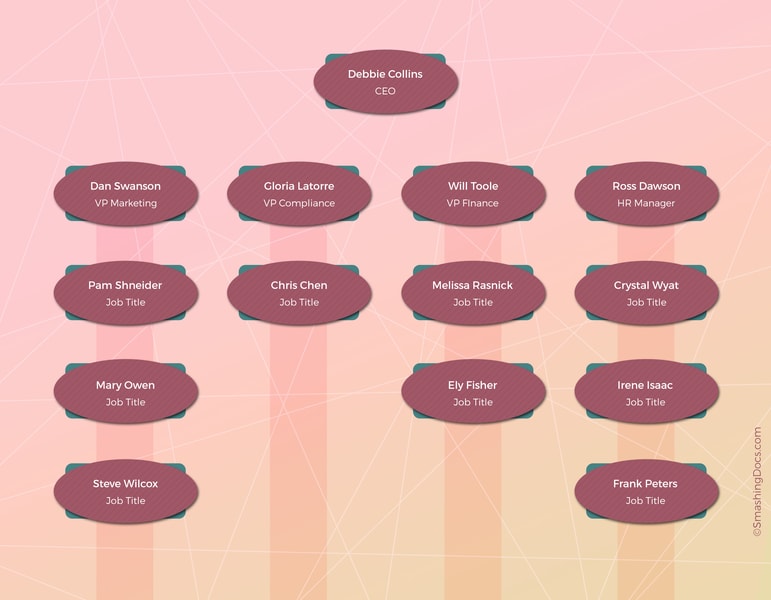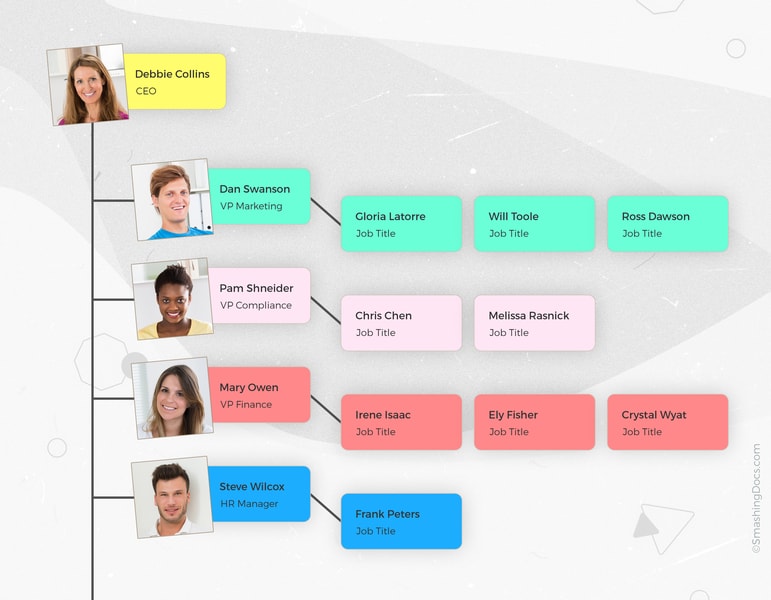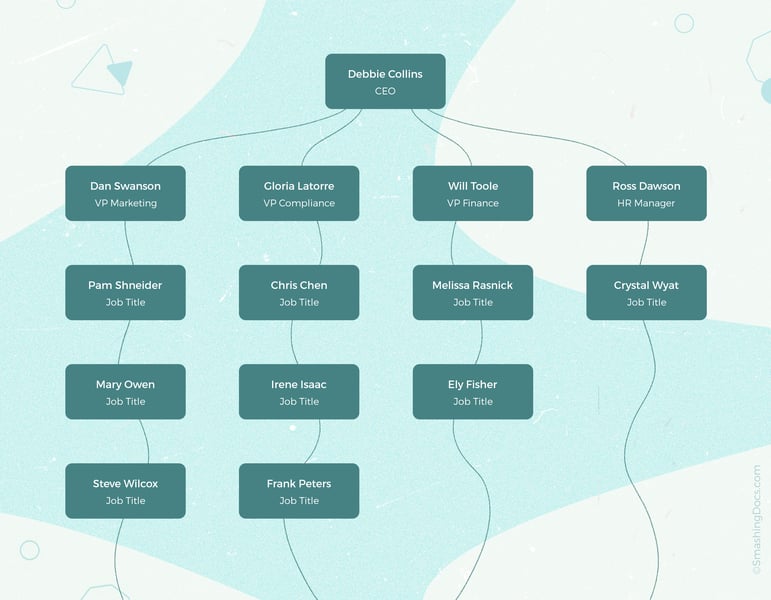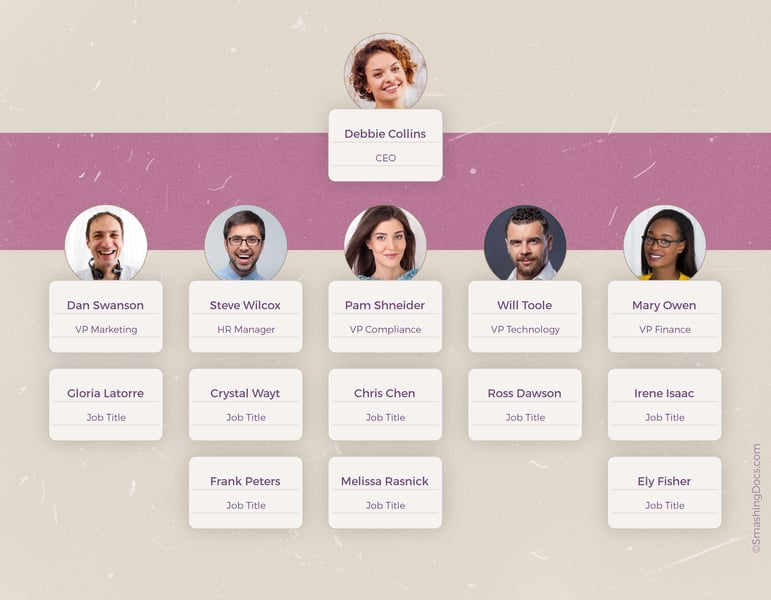
Organization Chart Templates for Top Teams
Create a visual breakdown of your main team roles to improve internal communication, reporting, and corporate governance.


Free Team Basics Colorful Organizational Chart Template

Free Organic Waves Organizational Chart Template

Free Uncluttered and Professional Organizational Chart Template
Organizational Charts: a Quick Explainer
An organizational chart (or org chart), is an illustration of your departments and teams’ composition with relationships, ranks, and reporting requirements mapped. New hires will be better able to understand how your company functions as a whole by seeing a diagram that shows all roles and positions.
What is the Purpose of Organizational Charts?
Organizational charts are primarily meant to inform all company members about your organization’s management structure, job hierarchy, and key roles. It acts as a visual prompt to understand the difference in ranks, roles, and job titles, plus figure out who’s the best person to contact for this or that.
Moreover organizational charts help:
- Map lateral and linear relationships between roles
- Decide the best path for issue escalation
- Improve communication and reporting flows
- Locate redundant or missing roles
- Improve the overall management structure of your company
Why Are Organizational Charts Important for Companies?
Organizational charts are important because they help each member of your company better understand their position on the corporate ladder and the overall chain of command. Even the simplest organizational chart template does a great job at minimizing the team an employee needs to decide which person they must contact for a specific issue or whom to cc on a certain email.
Additionally, by visualizing your organizational structure, you can better understand the current team/department composition to figure out:
- Possible career progression for different roles to provide better career development services to current and new employees
- Gaps and inefficiencies in reporting/management structures e.g. when one person reports to too many managers or a manager doesn’t have a big enough team for execution.
- The extra roles and competencies you might need on board aka the existing talent skills gaps.
Because an organizational chart is so easy to make (with a template especially!) almost every company with 10+ people has one.
4 Types of Organizational Charts
In the world of organizational structures, you have plenty of structural models to choose from. Some have proven to be more effective for smaller companies and agile startups, while others are better suited for larger enterprises. Though neither type of organizational chart is inherently worse than the other.
Hierarchical Organizational Structure
A hierarchical org chart is the “classic” one. It follows a bottom-up approach to building the chain of command — from the most senior person (founder/CEO) to the lowest level roles (e.g. intern or department assistant).
Visually, hierarchical organizational chart templates resemble a pyramid. You have a few people on top and the most at the bottom. Most authority and directives sprinkle from the highest levels to the lowest – and reporting, on the contrary, happens bottom-up.
Best suited for: Larger organizations with several departments or smaller companies with vertical leadership.
Flat Organizational Structure
A flat org structure emerged as an alternative to hierarchical leadership. It limits the “middle management” layer and has fewer ranks between top leadership and regular executioners. Because fewer people are involved in communication, reporting, and decision-making, flat structures are often seen as more efficient and conducive to distributed work (as information flows better and fewer approvals are required).
That said: a flat org structure might not work for every type of business. Because it assumes having knowledgeable, autonomous, and empowered front-line staff who can make decisions without constant supervision or instructions from the above.
Best suited for: Smaller tech companies and customer-centric organizations.
Functional Organizational Structure
As the name implies, a functional org structure assumes departmentalizing your organization by certain business functions e.g. sales, operations, marketing, finance, customer service, etc. Each department has an internal hierarchy and reports to upper-level management.
Most companies function this way because it allows a high degree of employee specialization and effective collaboration within business functions. The drawback, however, is that functional departments often operate in silos, meaning directions and information flows don’t always happen fast and people might lack knowledge of what other departments are doing.
Best suited for: Retail and ecommerce companies, financial services providers, and large-to-mid-sized companies.
Cross-Functional Organizational Structure
A cross-functional organizational structure assumes meshing together people with different skillsets/roles into teams based on criteria such as:
- Product/service (or its element)
- Projects
- Target markets
- Geographies
A cross-functional team acts as a self-sufficient unit that can cover the allocated scope of work (e.g. sell a service in EMEA) without relying on other units. This organizational structure type is hard to implement from the get-go. But once you get things right, you’ll likely end up with a more productive workforce.
Best suited for: Tech startups, agencies, small-to-mid market companies.
Start charting your company structure using a free organizational chart template from SmashingDocs!
